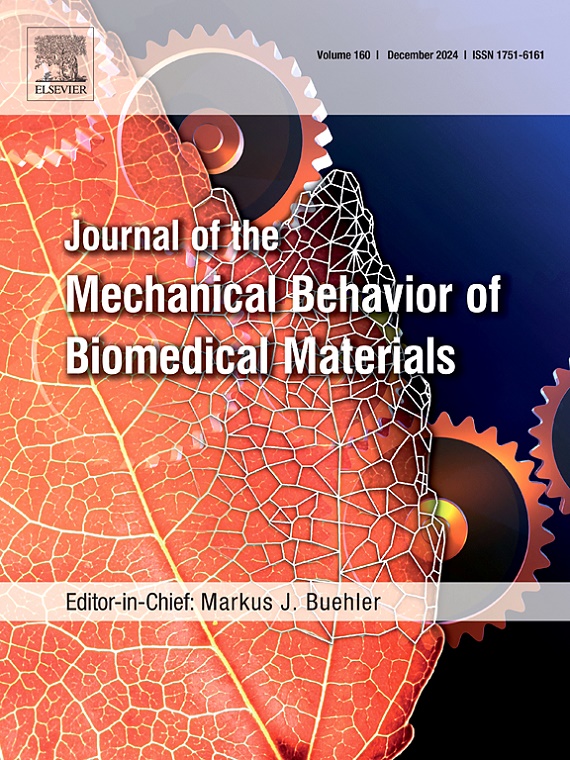预测脊椎在压缩、屈曲、伸展和侧弯等一般负荷下的破坏情况。
IF 3.3
2区 医学
Q2 ENGINEERING, BIOMEDICAL
Journal of the Mechanical Behavior of Biomedical Materials
Pub Date : 2024-11-20
DOI:10.1016/j.jmbbm.2024.106827
引用次数: 0
摘要
骨质疏松症和骨转移等骨骼病变会严重影响脊柱的承重能力,增加椎体骨折的风险,其中一些可能发生在日常体力活动中。目前,还没有一种临床工具能准确评估骨质疏松症和转移性脊柱在这些活动中发生椎体骨折的风险。在本文中,我们开发并验证了一种基于计算机断层扫描的定量有限元分析(QCT/FEA)方法,用于预测在模拟屈曲、伸展和侧弯运动的一般载荷条件下的椎体骨折,以反映人体在各种情况下的活动。最初开发的是尸体脊柱群的 QCT/FEA 模型。该方法的准确性和验证包括将骨折力结果与纯压缩加载情况下的实验观察和测量结果进行比较。研究结果表明,实验测量的破坏载荷与计算估算的破坏载荷之间存在很强的相关性(R2 = 0.96,p<0.05)。本文章由计算机程序翻译,如有差异,请以英文原文为准。
Prediction of vertebral failure under general loadings of compression, flexion, extension, and side-bending
Bone pathologies such as osteoporosis and metastasis can significantly compromise the load-bearing capacity of the spinal column, increasing the risk of vertebral fractures, some of which may occur during routine physical activities. Currently, there is no clinical tool that accurately assesses the risk of vertebral fractures associated with these activities in osteoporotic and metastatic spines. In this paper, we develop and validate a quantitative computed tomography-based finite element analysis (QCT/FEA) method to predict vertebral fractures under general load conditions that simulate flexion, extension, and side-bending movements, reflecting the body's activities under various scenarios. Initially, QCT/FEA models of cadaveric spine cohorts were developed. The accuracy and verification of the methodology involved comparing the fracture force outcomes to those experimentally observed and measured under pure compression loading scenarios. The findings revealed a strong correlation between experimentally measured failure loads and those estimated computationally (R2 = 0.96, p < 0.001). For the selected vertebral specimens, we examined the effects of four distinct boundary conditions that replicate flexion, extension, left side-bending, and right side-bending loads. The results showed that spine bending load conditions led to over a 62% reduction in failure force outcomes compared to pure compression loading conditions (p ≤ 0.0143). The study also demonstrated asymmetrical strain distribution patterns when the loading condition shifted from pure compression to spine bending, resulting in larger strain values on one side of the bone and consequently reducing the failure load. The results of this study suggest that QCT/FEA can be effectively used to analyze various boundary conditions resembling real-world physical activities, providing a valuable tool for assessing vertebral fracture risks.
求助全文
通过发布文献求助,成功后即可免费获取论文全文。
去求助
来源期刊

Journal of the Mechanical Behavior of Biomedical Materials
工程技术-材料科学:生物材料
CiteScore
7.20
自引率
7.70%
发文量
505
审稿时长
46 days
期刊介绍:
The Journal of the Mechanical Behavior of Biomedical Materials is concerned with the mechanical deformation, damage and failure under applied forces, of biological material (at the tissue, cellular and molecular levels) and of biomaterials, i.e. those materials which are designed to mimic or replace biological materials.
The primary focus of the journal is the synthesis of materials science, biology, and medical and dental science. Reports of fundamental scientific investigations are welcome, as are articles concerned with the practical application of materials in medical devices. Both experimental and theoretical work is of interest; theoretical papers will normally include comparison of predictions with experimental data, though we recognize that this may not always be appropriate. The journal also publishes technical notes concerned with emerging experimental or theoretical techniques, letters to the editor and, by invitation, review articles and papers describing existing techniques for the benefit of an interdisciplinary readership.
 求助内容:
求助内容: 应助结果提醒方式:
应助结果提醒方式:


